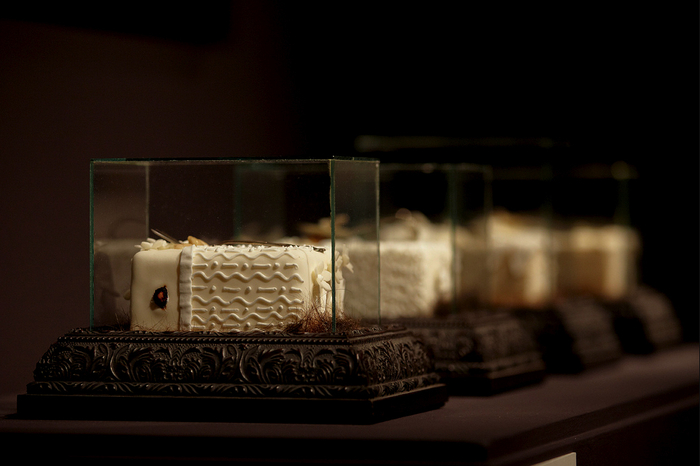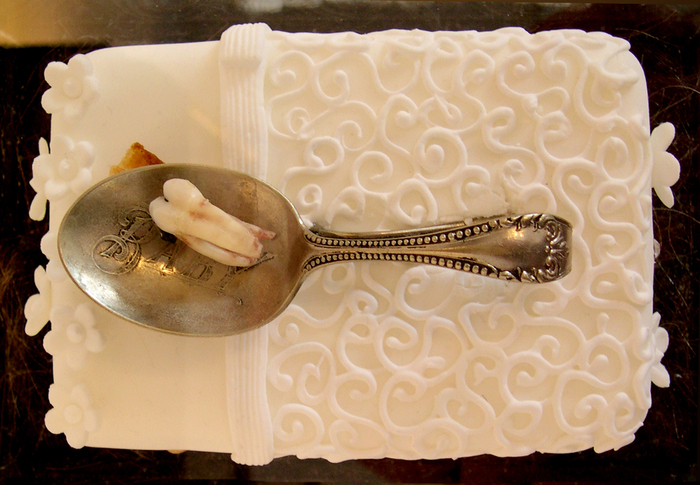Corps de l’article
A most unusual pâtisserie. Exceptionally high ceilings, expansive walls, and dramatic lighting. Elaborate displays of cakes in every size. Single tier and two tier. Icing finished with embossed rolling pins and crimpers. Sugar paste ribbons, small decorative beads, and sugar wired flowers. Not a chair or counter in sight. No napkins or cash register.
There is, in fact, nothing to eat here, but much to savour. The setting is an art gallery, and not a pâtisserie. The lighting is dramatic, but also specific, bringing emphasis to the predominantly white, sometimes ivory icing and decorative detailing of moulded blossoms, sugar cultured pearls, and in this case, inedible lustre.
It's quiet as a church, as if the whole place is wrapped in sound-deadening crepe.
Beside one ornately housed cake, a tag:
(cakes) cup II (Wing & Stone)
Royal icing, table runner, hair of a woman, hair of a man, molasses, melancholy, shark teeth, blueberry skin, weakness, cat claws, chalice, bodily oils, the holy spirit, sewing needles, icons, love, fossils, perfume bottles, blue, silver spoon, orb, fur of a rabbit, metal, glass, sadness, wood, horse hair, a pool of ripples, down feathers, wing, and stone, fondant icing
Hamilton, Burlington, Prague, ?, ?, ?, ?, ?
It reads like the ingredients to a recipe, or an incantation. Similar invocations accompany each of the cakes. On the walls hang tumescent paintings that project outwards and defy gravity.
Figure 1
(cake) breath
Royal icing, rib cage, hair of a boy, flowers, tendons, claws, glass eye, wisdom, bleach, water, lamb, skin, pearls, meadow, redpath, fondant icing.
Wales, Hamilton, Burlington, ?, ?, ?, ?, ?
Mixed Media, 2007
A tag:
(50 lbs) chapel (rose) (white and red) (of sweet sleep)
Fifty pounds to indicate the weight of oil paint miraculously fixed to canvas?
Figure 2
Cake: Fiona Kinsella
Installation view, Art Gallery of Hamilton, 2010
Hamilton, Ontario, Canada
Centre painting:
(50 lbs) chapel (rose) (white & red) (of sweet sleep)
Oil on canvas, 2008
24 x 24 inches
Cakes and paintings resonate with one another. The ambience suggests meditative calm. The austere fondant of the cakes, the regimented lines of the frames, the formality of the gallery—these things negate the gaiety of cakes and the celebrations they animate. Everything seems ordered, prescribed.
Figure 3
Cake: Fiona Kinsella
Installation view, Art Gallery of Hamilton, 2010
Hamilton, Ontario, Canada
Curated by Melissa Bennett
Inside the gallery, tension builds. The room is dark and the lighting is specific, drawing attention to details. Teeth. Many different kinds of teeth. Bones. Bullets. Hair. A great deal of hair. The tags are not meant to mislead. Was it midnight when Kinsella called upon the pixies, goblins, brownies, and wirry-kows? Did they help her decorate the cakes with insect wing, porcupine quill, and glass eye by the light of will-o-wisp? Or was Kinsella a victim of their mischief, and changelings now inhabit the gallery?
Figure 4
(cake) cutting (tooth)
Royal Icing, baby spoon, lock of hair, teething, upper left sixth, boy, silver and rhinestones, glass, wood, fondant icing.
London, Hamilton, Burlington, ?
Mixed Media, 2007
Four small rectangular tomb-like cakes lie side by side. On one rests a spoon. The handle of the spoon takes the form of a dragon—and the bowl of the spoon holds a heart-shaped human tooth. The cake is named for Saint Vincent De Paul and references the miracle of his incorruptible heart. Another small cake boasts a little fork with three tines exhibiting human skin and animal bone. A third cake is titled cutting tooth and displays a silver baby spoon cradling a long rooted and slightly bloodied adult tooth. A fourth coffin cake named Porcelain hosts six yellowed dentures. Each of the small cakes is framed by human hair, and upon each little bed lie relics of the once living.
Figure 5
(cake) porcelain
Royal Icing, silver fork, teeth, hair of a stranger, glass, wood, fondant icing.
London, Hamilton, Burlington, ?
Mixed Media, 2007
Figure 6
(cake) ether (soul)
Royal Icing, moth, hair of a woman, air, sleep, glass, wood, fondant icing.
Thailand, Hamilton, Burlington, ?
Mixed Media, 2007
Larger cakes, such as Protector, Breath, Metamorphosis, and Ether, integrate glass eyes, rib bones, fox teeth, seeds, and insects. The materials provoke an experience beyond the visual; they draw upon instincts as fundamental as your salivary glands.
Figure 7
(cake) protector I
Royal icing, glass eyes, rhinestones, earrings, hair of a child, wood, glass, fondant icing.
Hamilton, Burlington, Wales, ?, ?, ?
Mixed Media, 2007
Some of Kinsella’s paintings are heaped like luxuriant mounds of icing or whipped cream, others are fecund groupings of roses, and finally there are those that reveal subterranean strata. These last are not mounted on the wall; they sit flat pushing upward from their pedestals. Paintings become sculptures. Their scale, orientation and suggestive edibility bring us full circle back to the cakes. The organic nature of Kinsella’s pedestal paintings are suggestive of exfoliate heads—those church or tombstone carvings of leafy vines that gradually reveal a face. Sometimes the Green Man, with leafy hair or beard, peers out of the foliage. Other times the vines and branches explode from mouth and ears.
Figure 8
(cake) tongues (babel)
Royal icing, fangs, snake head, porcupine quills, gold heart, bone tusks, rhinestones earring, angel hair, skin, wood, glass, redpath, fondant icing.
Hamilton, Burlington, Nevada, Thailand, ?, ?, ?
Mixed Media, 2007
"God is in the details," whether attributed to Ludwig Mies van der Rohe, or Aby Warburg, or Gustave Flaubert, is an exhortation. Kinsella has taken this to heart and become an ecstatic practitioner of detail-making. The Devil is in the details too. Where does one get the taxidermied head of a viper when that’s what you need to make your point? I’m just wondering.
Figure 9
Cake: Fiona Kinsella
Installation view, Art Gallery of Hamilton, 2010
Foreground painting:
(22lbs 8 ounces) cake (bouquet/helmet)
Oil on canvas, 2010
Flowers are a recurring motif on the cakes, and roses dominate the paintings, but they are not the flowers of Henri Fantin-Latour, or Claude Monet, or even Georgia O'Keefe, although they recall the worm-eaten rose of William Blake’s Songs of Experience.
With time, and this exhibition insists that you give it time, there is an easing of tension. Jarring discoveries grow less percussive.
Sara Knelman, a curator familiar the artist’s work, explains that,
Fiona Kinsella invites us to explore our psychological geographies. Like a book or poem, her intricate creations build a fiction that can lead us away from the everyday. By mixing together elements of history and memory, Kinsella’s work opens up possibilities for moments of epiphany. Kinsella’s cakes may not be edible, but they are meant for consumption, and the act of ingesting them brings intense emotions to the fore. The ingredients can perhaps be read as a map… the components—as ethereal as finger prints and as tangible and indestructible as teeth—reference universal rituals we can all recognize: birth, death, love, loss and decay. The media lists that accompany the works read like sublime recipes; the combinations of sweetness and duress, literally sugar and tears, suggest joy and heartbreak in a simultaneous instant. In these impossible combinations, Kinsella beckons us toward the uncomfortable challenge of the unfamiliar, and the possibility in that wilderness of finding truth through unadulterated, unmediated reactions.[1]
Melissa Bennett, Curator of Contemporary Art at the Art Gallery of Hamilton, writes, “Kinsella’s works provoke quiet shock and awe, and hint at a pilgrimage one might take towards spiritual understanding.”[2]
The viewer moves from cake to painting and from tag to tag.
There is an encompassing overall impression and a multitude of vignettes.
There is Artistry—skills learned, practised, and painstakingly presented.
Figure 10
Cake: Fiona Kinsella
Installation view, Art Gallery of Hamilton, 2010
Hamilton, Ontario, Canada
Oil on canvas
Curated by Melissa Bennett
Parties annexes
Acknowledgements
Fiona Kinsella would like to acknowledge the generous support of the Ontario Arts Council, an agency of the Government of Ontario. Paul Lisson also acknowledges the assistance of the Ontario Arts Council with thanks, having received a Writers' Reserve grant in 2011.
Biographical note
Paul Lisson is a librarian and archivist and edits HamiltonArts & Letters magazine. Paul's writing has appeared in Versal, the Beloit Poetry Journal, and Prism International, among others. His artwork has appeared in magazines including Descant and the White Water Journal.
Notes
Parties annexes
Note biographique
Bibliothécaire et archiviste, Paul Lisson édite le magazine Hamilton Arts & Letters. Ses écrits ont été publiés, entre autres, dans Versal, le Beloit Poetry Journal et Prism International. Ses oeuvres artistiques ont paru dans des magazines tels que Descant et le White Water Journal.
Liste des figures
Figure 1
(cake) breath
Figure 2
Cake: Fiona Kinsella
Figure 3
Cake: Fiona Kinsella
Figure 4
(cake) cutting (tooth)
Figure 5
(cake) porcelain
Figure 6
(cake) ether (soul)
Figure 7
(cake) protector I
Figure 8
(cake) tongues (babel)
Figure 9
Cake: Fiona Kinsella
Figure 10
Cake: Fiona Kinsella












